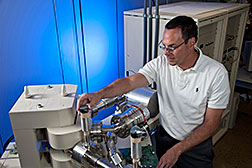- Number 397 |
- September 16, 2013
SRNL's Cordaro helps keep nation's data safe

Joe Cordaro.
While his home base is DOE's Savannah River National Laboratory, Joe Cordaro is a man who keeps his suitcase nearby and his passport up to date.
Cordaro, whose background is in both electrical and computer engineering, is recognized across the DOE complex and internationally as an expert in nuclear instrumentation, process control and high speed data acquisition.
He’s done extensive work in coulometry, not only for the Savannah River Site, but also internationally. He and a colleague developed an automated controlled potential coulometer for the measurement of plutonium, independent of certified reference material. More recent work builds off of his background in nuclear materials work, but is also expanding in directions that aren’t necessarily associated with traditional SRS missions.
“So much of what we do is in hot cells and gloveboxes, and it can be extremely complex and expensive to bring equipment into those areas. The solution can be wireless, but the showstopper is security,” he said. “The challenge is to solve the security issues, since we’re usually working with classified data.”
Most recently, he was instrumental in a successful collaboration with the National Security Agency (NSA) on a design for classified data transmission without the use of traditional Type 1 encryption products. The new secure wireless network design could be used for sensors across the DOE complex, in addition to uses by other federal agencies and industrial control systems at critical manufacturing facilities across the nation.
Wireless sensors address a need that’s particularly applicable to DOE and NNSA work, and it led Cordaro and an SRNL team into an additional project that could have far-reaching applications in the wireless communications field.
Working with law enforcement customers, and with other partners – Boeing, On-Ramp Wireless and others – Cordaro and a group of SRNL colleagues developed and demonstrated that multiple technologies can be integrated into a single device that provides seamless remote tracking, world-wide, indoors and in locations where Global Positioning System (GPS) will not work. The system has the potential to improve nationwide capabilities for law enforcement, community corrections, special response teams, SWAT teams, other first responders, materials tracking, and other customers that are steadily being identified.
Cordaro has also become a “fix-it” specialist for legacy electronics systems at SRS and throughout the complex.
Through the Network of Senior Scientists and Engineers (where Cordaro is a former chair), he’s been heavily involved in efforts to upgrade equipment at sites such as Sandia, Pantex, Paducah and others. “I’ve had a good opportunity to see the needs of the National Security Enterprise across the board, and it’s helped me really focus and target what I’ve worked on. The NSSE spearheaded a collaboration in upgrading mass spectrometry equipment; in a lot of cases we’re talking about equipment that’s really critical, and we’ve gotten the “Dear John’ letter from the vendor saying you’re on your own. There’s going to be a lot more work in upgrading electronics in similar legacy equipment that vendors don’t support any more.”
Joe graduated from the State University of New York in Buffalo, and opted for the milder winters of South Carolina. He has numerous publications and nine inventions, including one patent and two pending, including a pending patent for an electrometer that can accurately measure one femto-amp.
Like many of his generation, he found inspiration in the work of NASA.
“I grew up building those little electronics kits, then I was really addicted to following NASA, particularly during the development of the shuttle,” he said. With a push from a neighbor who worked for DuPont, he followed his older brother to what is now the Savannah River National Lab.
Cordaro began as a summer student, and began full-time work in an Equipment Engineering Group that provided staff support for operations throughout the Savannah River Site. “That group morphed into a really good development group,” he said, “and I think we have a really great field group today.” Recent field installations have taken him to assignments as far flung as Vienna and Japan.
And, he says, some of the greatest satisfaction happens when the call arrives from elsewhere in the DOE complex.
“It’s very gratifying when we do work for the other Labs,” he said. “To get the calls from people at Sandia, from Los Alamos, from our peers at places like those, is good validation of the work we do. It tells me we’re working on the right things, and that we’re really providing something that’s recognized as valuable.”Submitted by DOE's Savannah River National Laboratory
